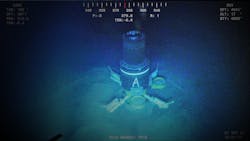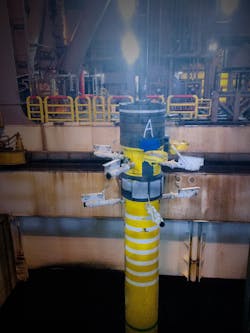Innovative subsea wellhead system installs in a single trip
Offshore oil and gas developments are moving into extreme HP/HT environments that introduce significant technology challenges. Reliability is essential in these critical service conditions, making subsea wellhead system performance paramount to operators. Equipment manufacturers are working to meet operators’ demands with systems that provide dependable service and address cost concerns, which are top of mind in an industry where budgets are more and more constrained. Recent successful installations of newly designed 15K and 20K subsea wellhead systems demonstrate that it is possible to exceed today’s performance criteria with innovations that also improve project economics.
Stepping up performance
Installing a subsea wellhead lockdown device the traditional way is a multi-step process that requires several trips into and out of the well, beginning with round tripping a lead impression tool to measure the spacing between the top of the hanger and the lockdown sleeve grooves. The next run sets the lockdown sleeve, which secures the hangers to provide containment in the case of a spike in well pressure. A third run is required to place the seat protector to safeguard the upper interface of the lockdown sleeve. In addition to installing all this equipment, each component must also be retrieved to complete the well. This accounts for two more trips down into the well. In production mode, an additional set of trips is required to install a production lockdown sleeve to interface with the tree seal.
The elapsed time for each trip varies based on well depth and other considerations, but tripping in and out of the hole typically takes around 10 hours. If any steps do not go as planned, the errant trip must be repeated, adding even more time and operational costs, as well as increasing risks. Without a way to ensure proper wellhead component installation, operators are forced to follow a time-consuming installation program that requires a vessel and installation crew for the duration of the deployment and significantly more rig time.
The Dril-Quip BigBore IIe (BB IIe) Subsea Wellhead System design eliminates the need for a lockdown sleeve. This is accomplished by means of an integrated lockdown ring with a metal-to-metal seal assembly that provides 2 million lb. of hanger lockdown capacity at 20 ksi. Rated for 400°F (204.4°C) and durable enough for H2S service, the system performs reliably in HP/HT conditions.
By eliminating the lockdown sleeve, this design also reduces the number of trips into and out of the well. The BB IIe hanger and seal assembly are installed using the same casing hanger seal assembly running tool (CHSART) that Dril-Quip uses to install all its subsea systems. If for any reason, the seal is not properly set, it comes back with the tool, which means there is no need for an additional trip to retrieve the seal. This ‘smart’ feature ensures that if there is improper placement, the seal is never left behind.
For normal and high fatigue applications, the subsea wellhead system is fitted with the Dril-Quip DXe wellhead connector. This connector is suitable for BOP stack, subsea tree, and riser tieback services. It is designed for HP/HT service and can perform reliably in shallow-water service, where severe bending and high-fatigue HP/HT conditions must be met as well as in hyper-deep water (15,000 ft/4,572 m) applications.
Putting the system to work
This proprietary subsea wellhead system delivers permanent cost savings, eliminating up to five trips into the well and by doing so, decreases installation time. The first installations of this system were carried out in the Gulf of Mexico for Murphy Exploration & Production Co. on the Samurai and Khaleesi wells in 3,349 ft (1,021 m) water depth in April 2021.
In preparation for the installation, technicians preassembled the CHSART and ran the prechecks in Houston, before transporting the tool to Pacific Drilling’s Pacific Sharav drillship. The low-pressure housings were batch-set on the Samurai 3, Samurai 4, and Khaleesi wells. Then the vessel returned to the Samurai 3 well to set the high-pressure housing and hanger seal system.
Because this was the first installation of the 15 ksi wellhead system, all crew members completed extensive procedural review and training prior to the installation. Using the CHSART, the crew set the hanger in the rotary and ran drill pipe to connect it to the tool. Once the tool was through the BOP and in the wellhead, the crew ran standard checks required by the operator before slacking off to land and set the hanger inside the wellhead. With the checks completed, the hanger was positioned in the wellhead and cemented in place.
With just six rotations, the CHSART dropped the seal assembly into place and continued to weight- and pressure-set the seal. When the pressure above the seal reached 7,500 psi, the seal was set and pressure tested. The running tool was brought back out of the hole to surface, completing the wellhead installation in a single trip that took only 10.5 hours. The CHSART came out of hole with no scratches, scars, or yielding, which meant that once it was cleaned, it could be rebuilt quickly to set up for the next installation.
By eliminating hardware, reducing rig time and requiring fewer workers to carry out the installation, this subsea wellhead system saved the operator approximately $200,000 on a single well. It is important to note that this conservative savings estimate does not factor in NPT. The advantages of the system extend beyond dollars and cents because it eliminates risks for offshore workers and decreases the carbon footprint of operations by significantly reducing the number of trips required for installation.
Stepping up the pressure
The 15 ksi system deployment in the GoM was followed a few months later by the installation of the world’s first 20ksi system with 2-million lb lockdown in 5,000 ft (1,524 m) water depth. The system was selected for this HP/HT project for two main reasons. First, the seal was rated to 20 ksi at 400°F (204°C) and, second, it featured a 2-million lb. lockdown rating, which eliminated the need for subsequent trips to run lockdown sleeves.
The casing plan for the well was unique, employing surface casing that allowed 16-in. and 18-in. casing to be set deep for full bore pressure up to the wellhead. This required the 16-inch hanger system to be rated for 15ksi at 350°F (177°C) and an 18-in. hanger system that could withstand 7ksi. Both systems were designed and developed specifically for this 20ksi project to meet the critical service ratings required.
The DXe mandrel and gasket profiles were also part of the system installed on this 20 ksi well. They were selected because of the superior fatigue resistance of the profile along with its 20 ksi rating on both the primary and secondary seals. When combined with the DXe profile and gasket profile, the system delivers industry-leading fatigue resistance with a design that accommodates stresses in the load path caused by rig mechanics, ocean currents, vortex-induced vibration, and high-pressure environments.
Another critical component of this HP/HT installation was a 23.5-in. BADGeR casing connector that was specially designed for this well. With a 1.04 SAF rating, the connector has the best-in-class fatigue rating in the industry. Fully qualified to temperatures that exceed those specified in API 5C5, it is the only connector available capable of withstanding the loading and fatigue requirements of these HP/HT wells. Because it allows for 100% handsfree installation, the connector also reduced safety risks during deployment by eliminating personnel in the red zone.
Despite the extreme conditions of this well and the application of multiple new technologies, the installation went according to plan with no accidents, incidents, or failures. All the components functioned exactly as designed, and the installation was carried out precisely as anticipated.
Evolving to meet industry needs
While the lower body of the current design is similar to its predecessor, the upper portion of the seal assembly was improved to enable the seal to deliver increased lockdown capacity. This version of the system more than doubles lockdown capacity, from less than 1 million lb. in the second-generation system to 2 million lb. in the e-Series version. This increased lockdown capability allows the lockdown sleeve to be eliminated. The recent 20 ksi installation is a testament to the evolution of the design and a continuing focus on extending the performance window for this technology.
Setting the standard
The energy industry is evolving, and both operating and market environments are introducing new challenges for operators. Finding a way forward will require new thinking and new technologies that change the way wells are constructed to minimize risk, improve environmental stewardship, and deliver better project economics.



